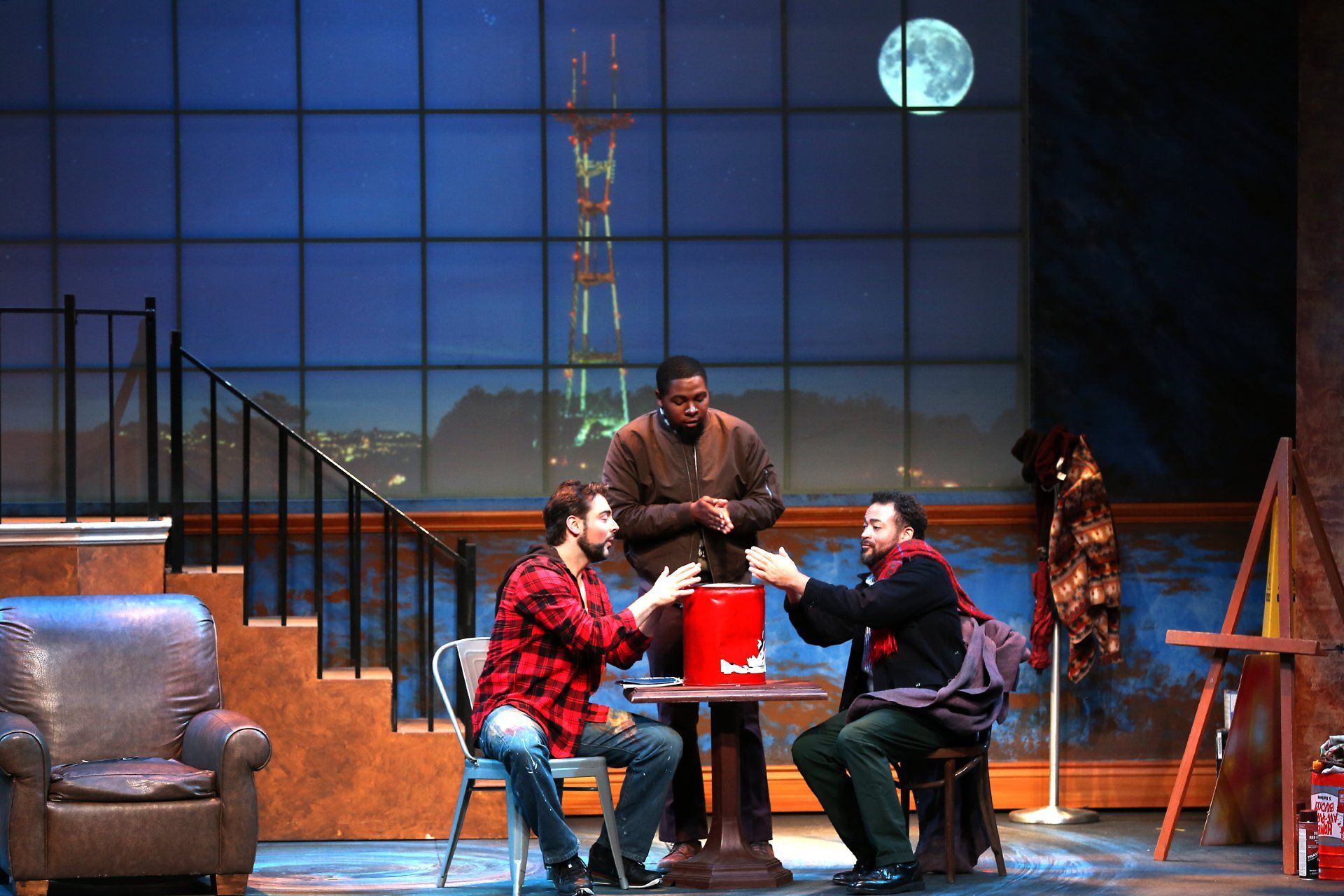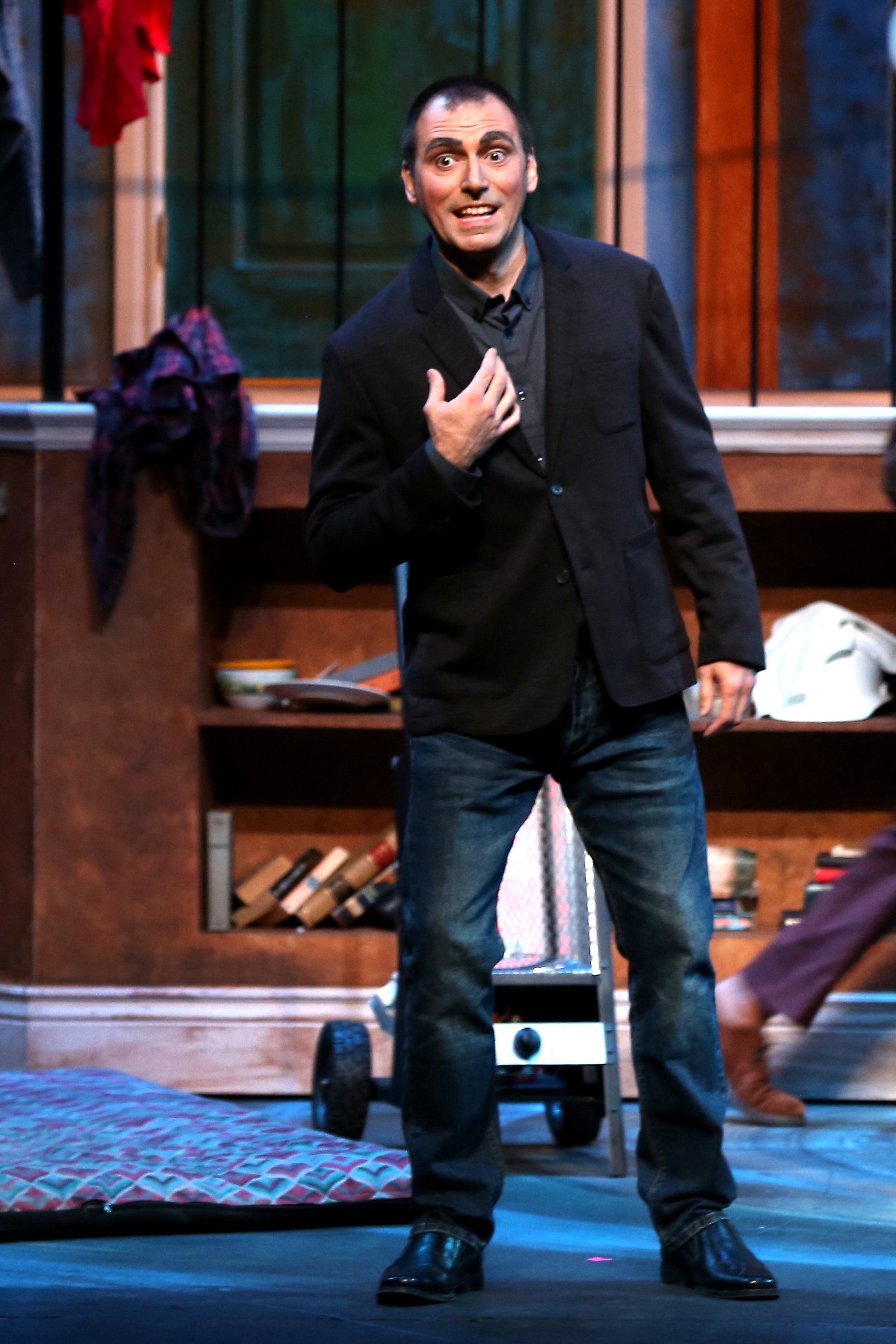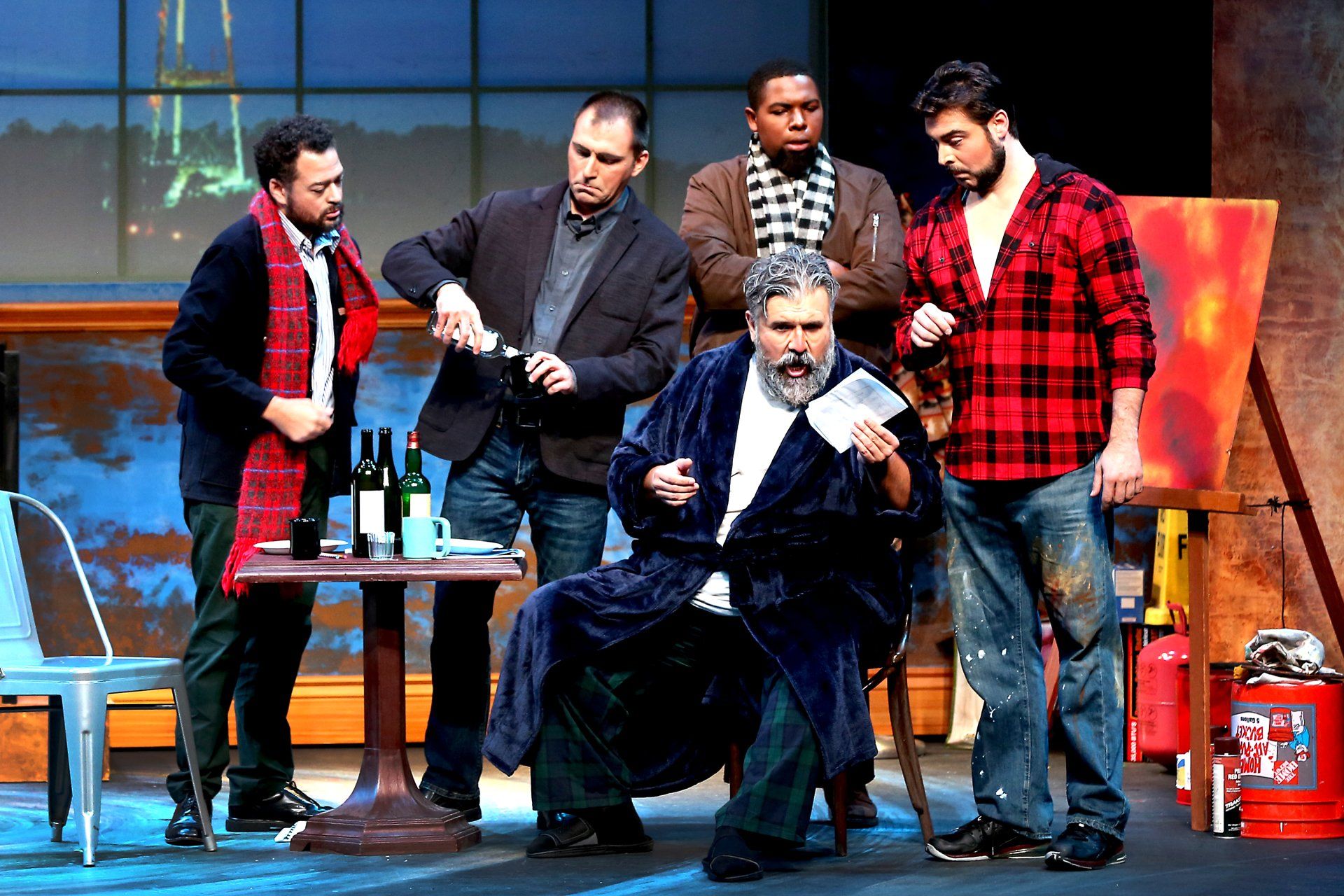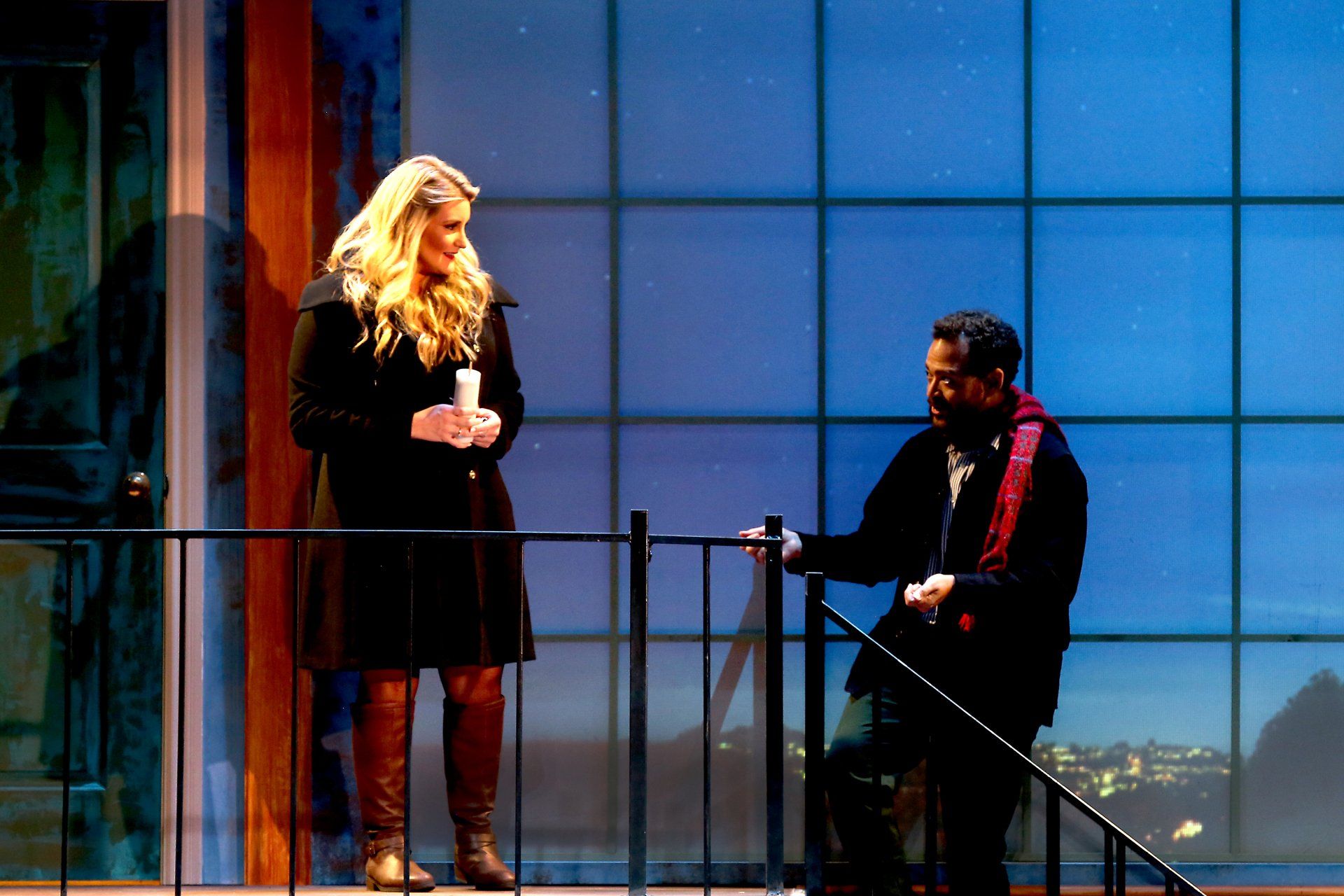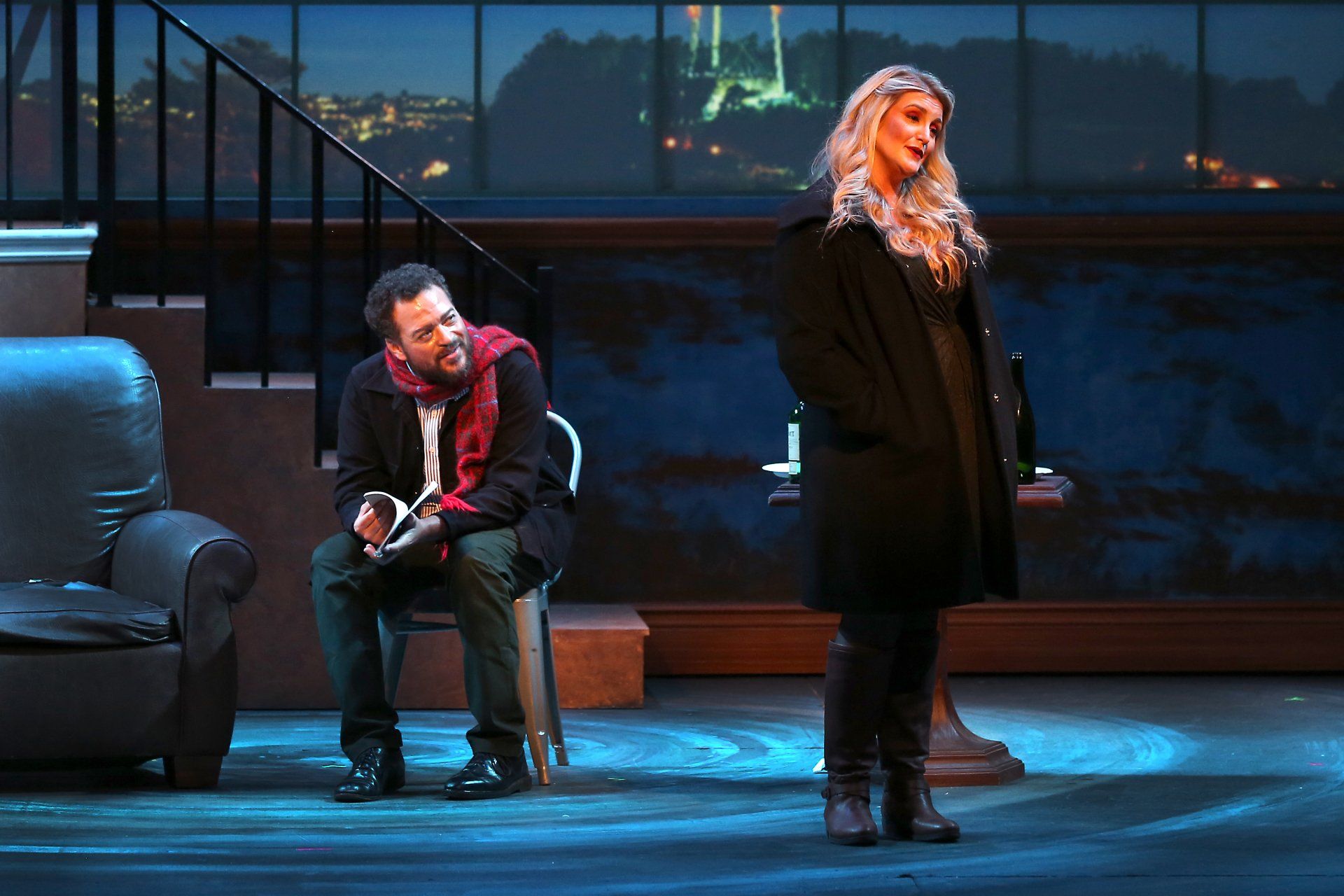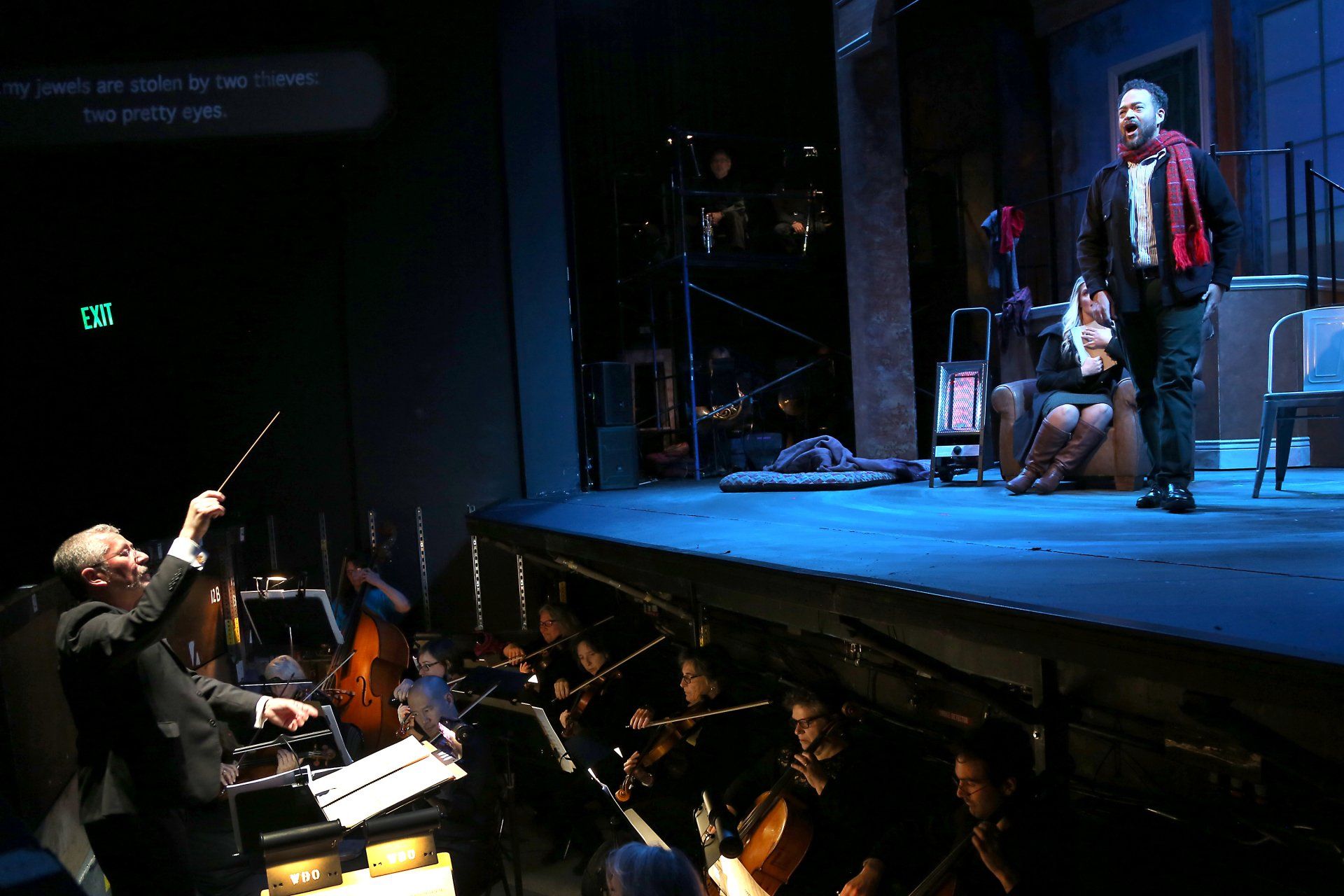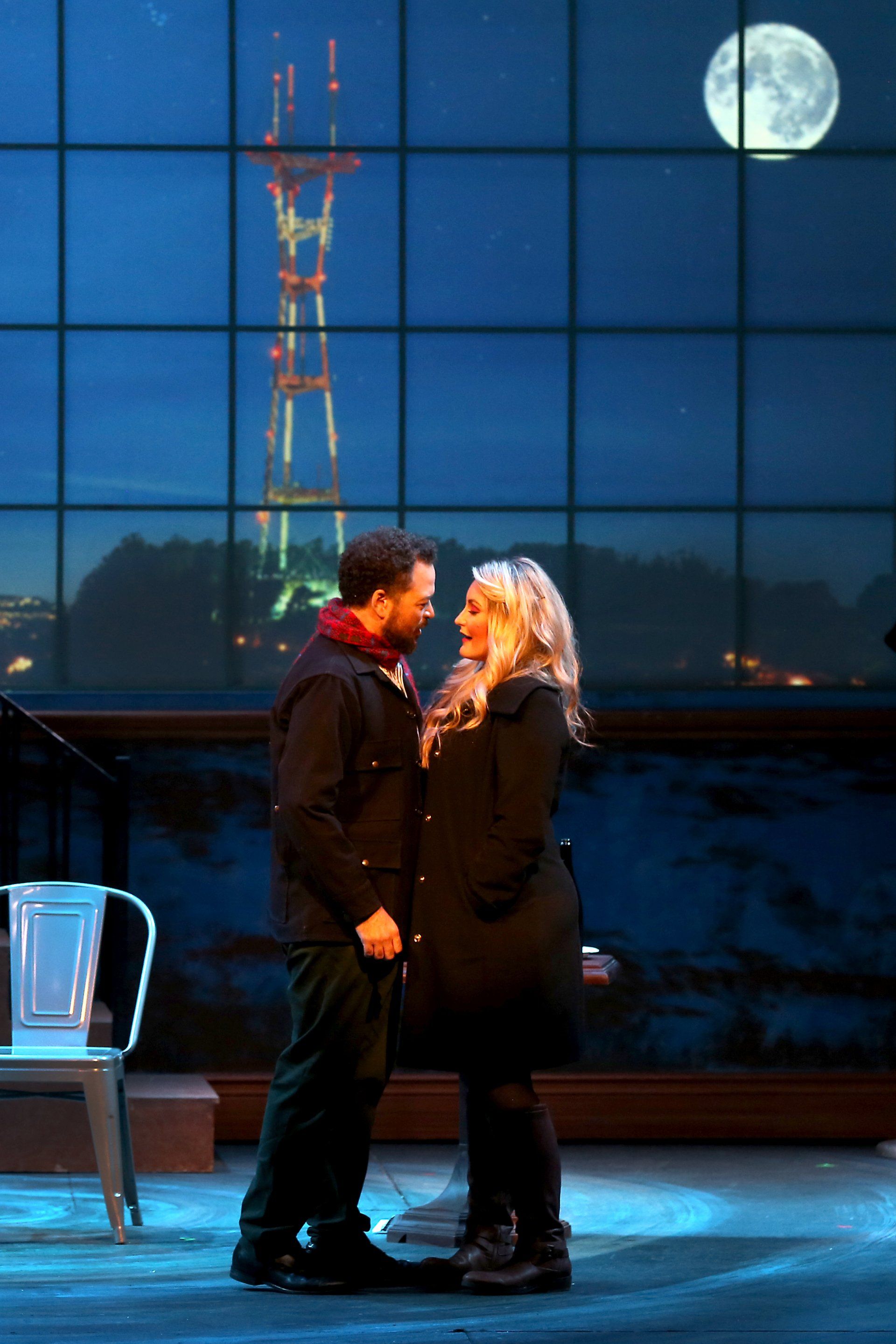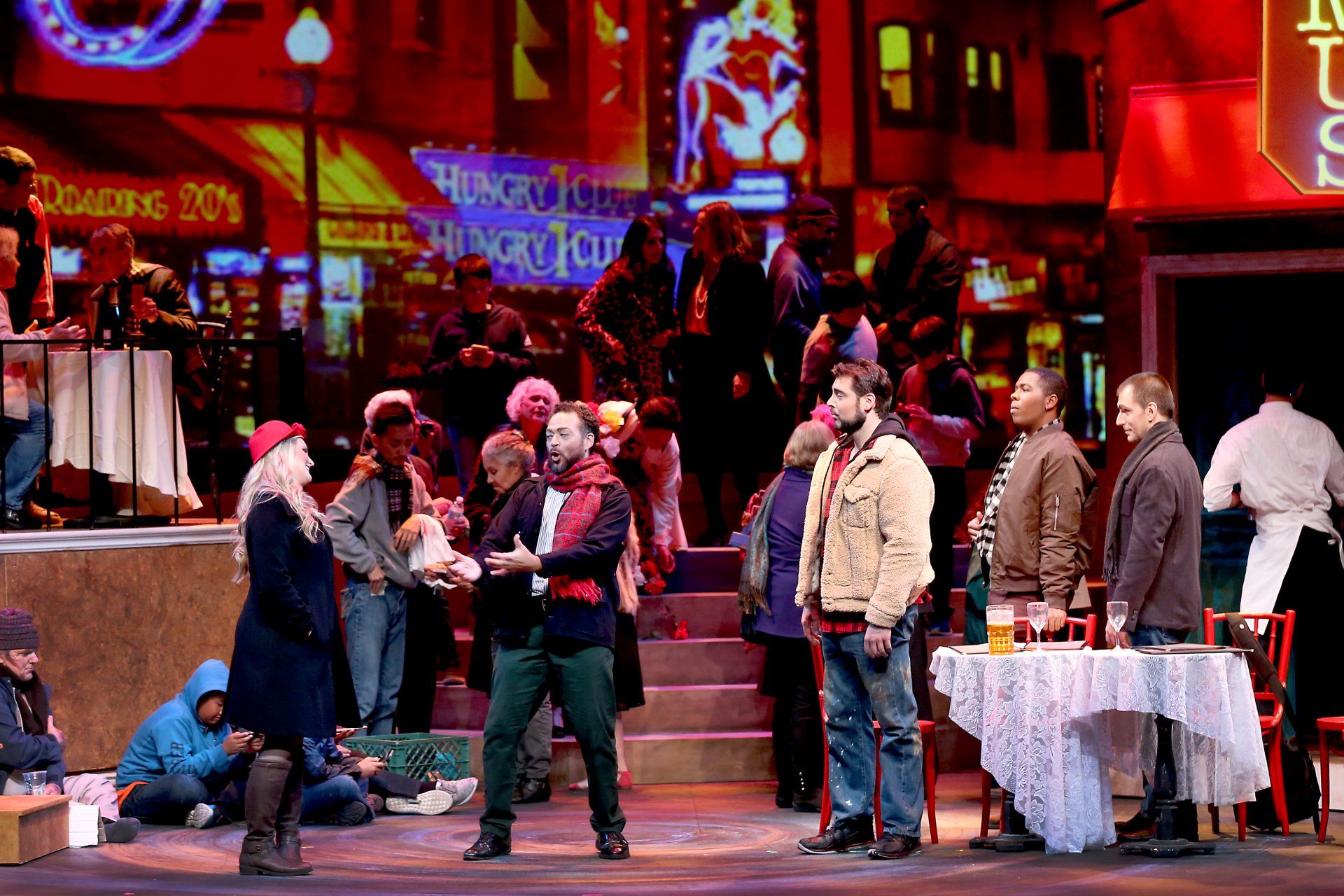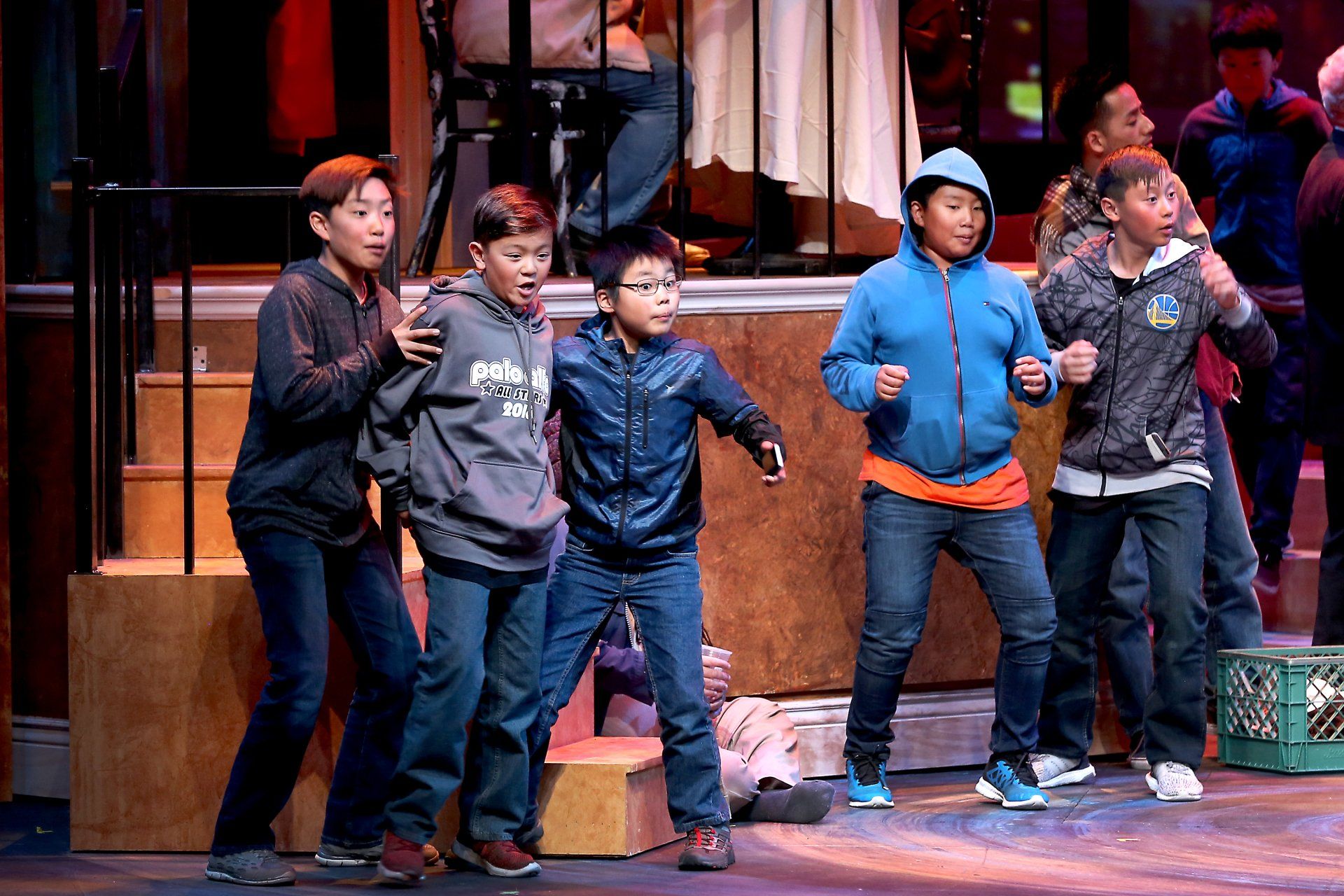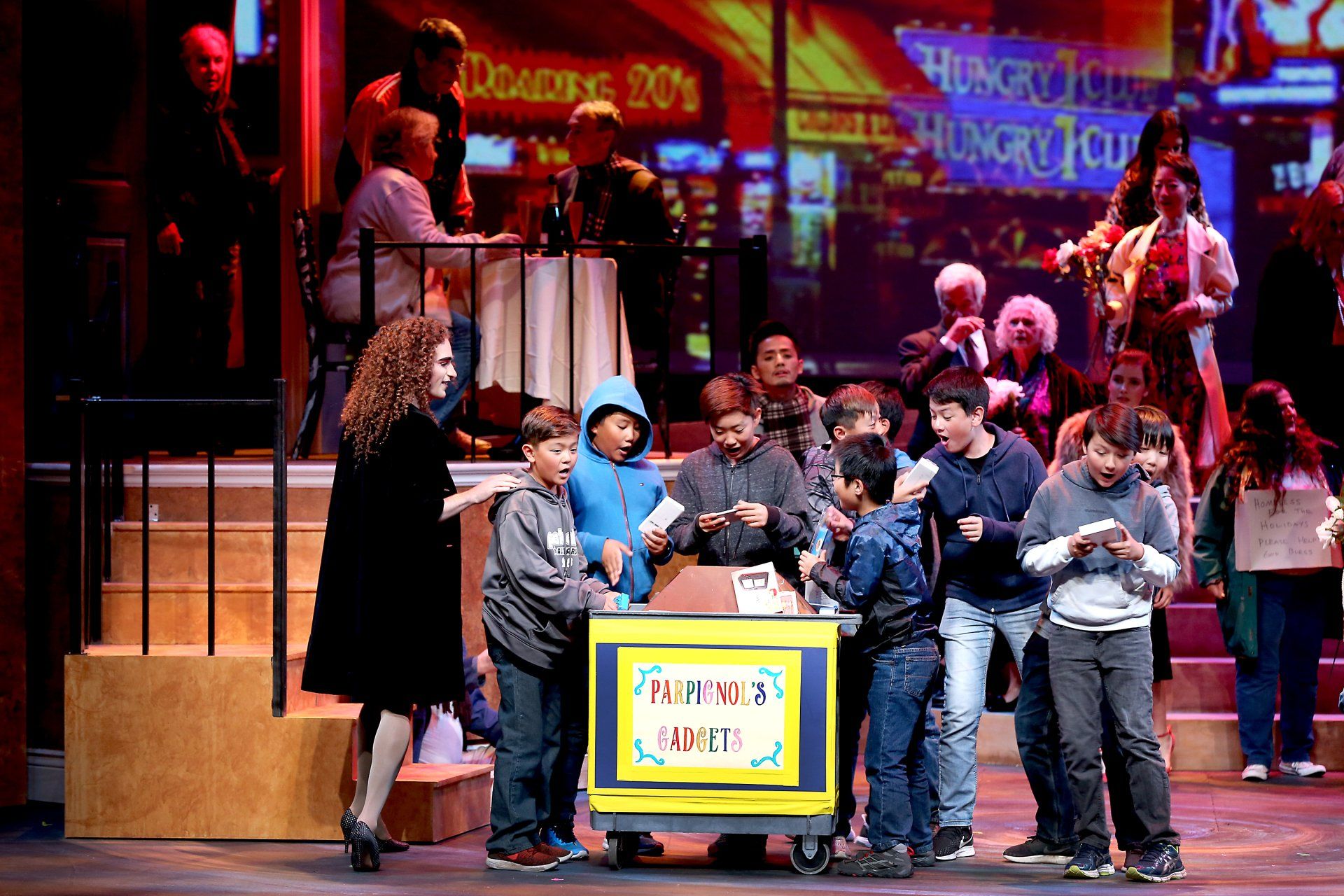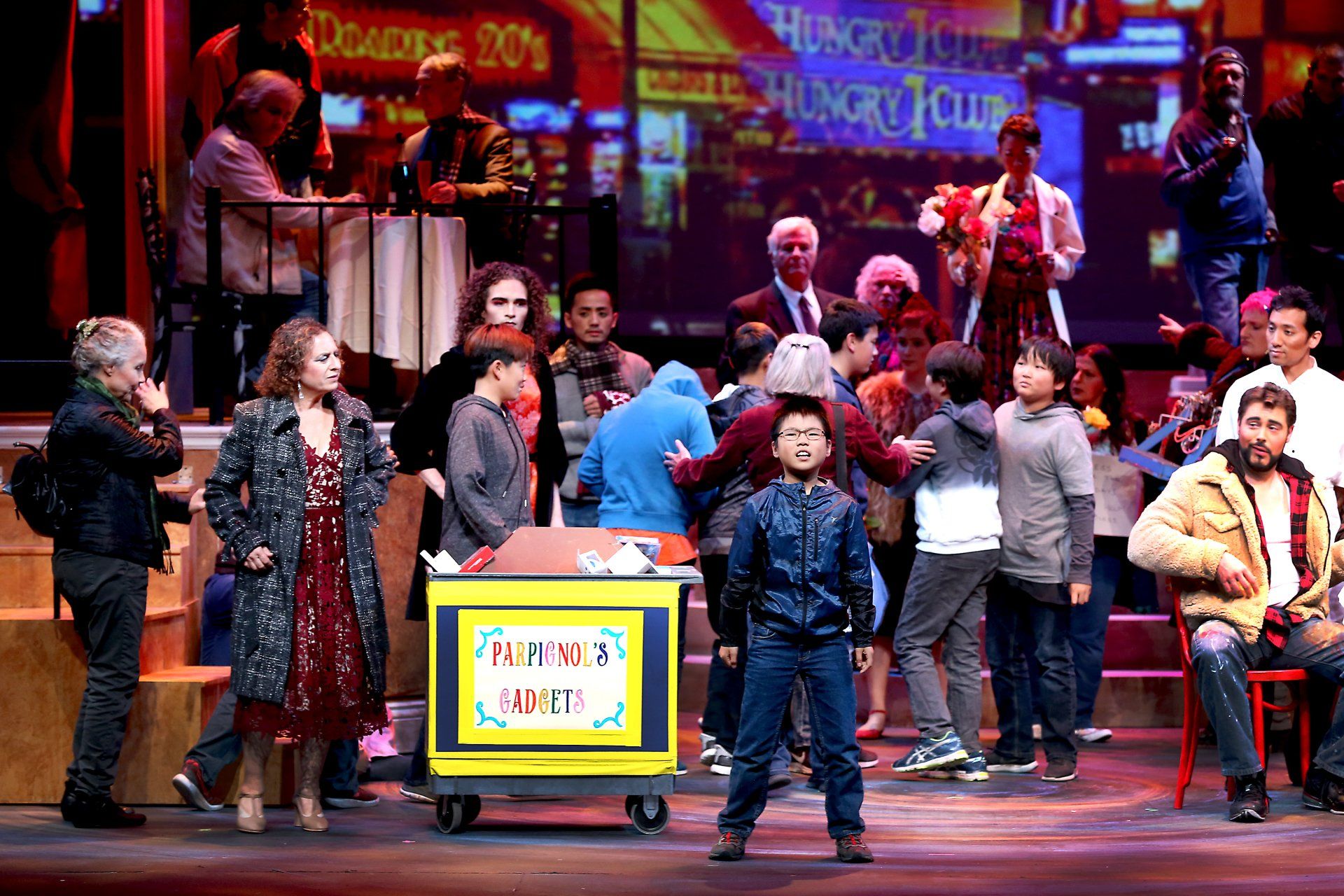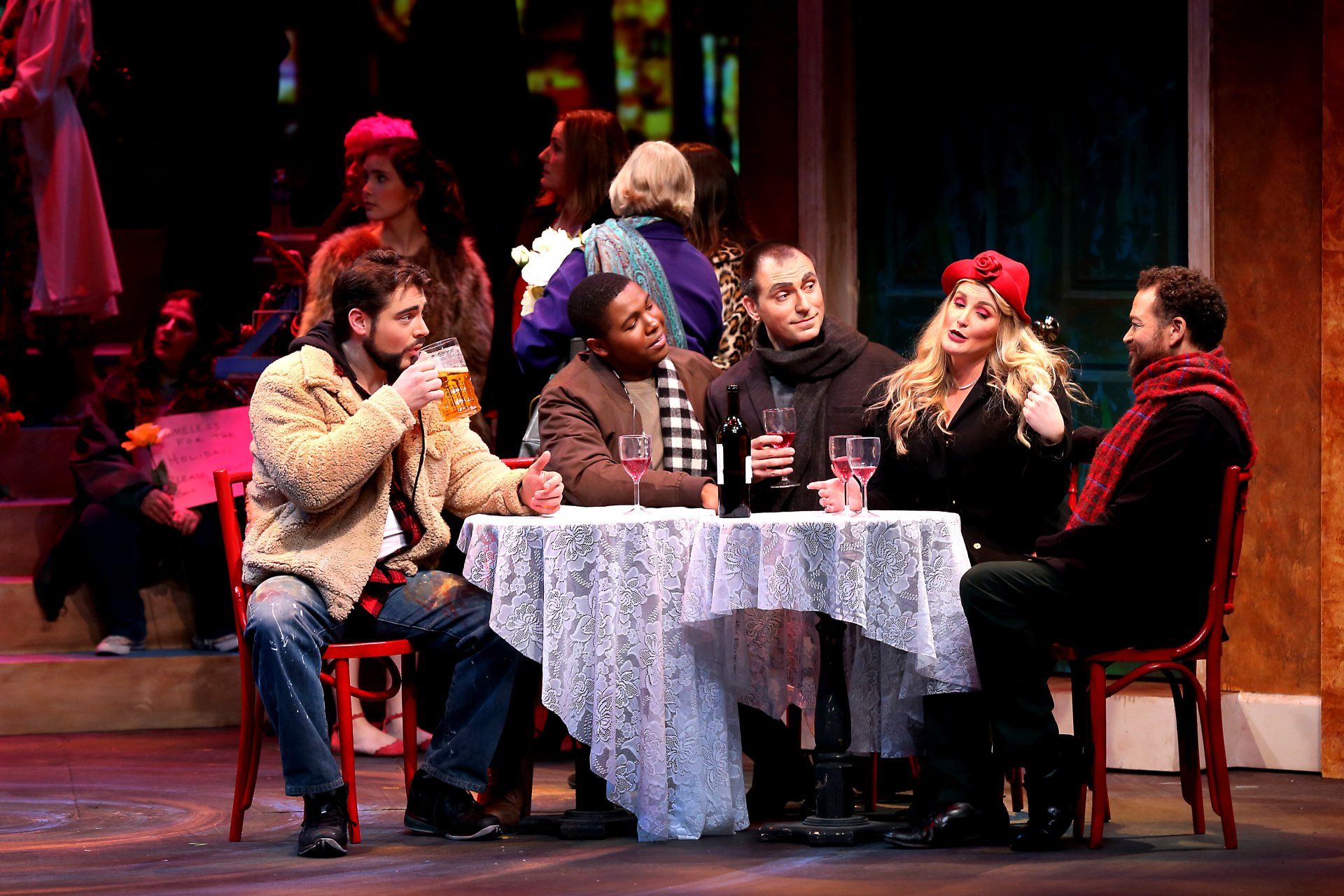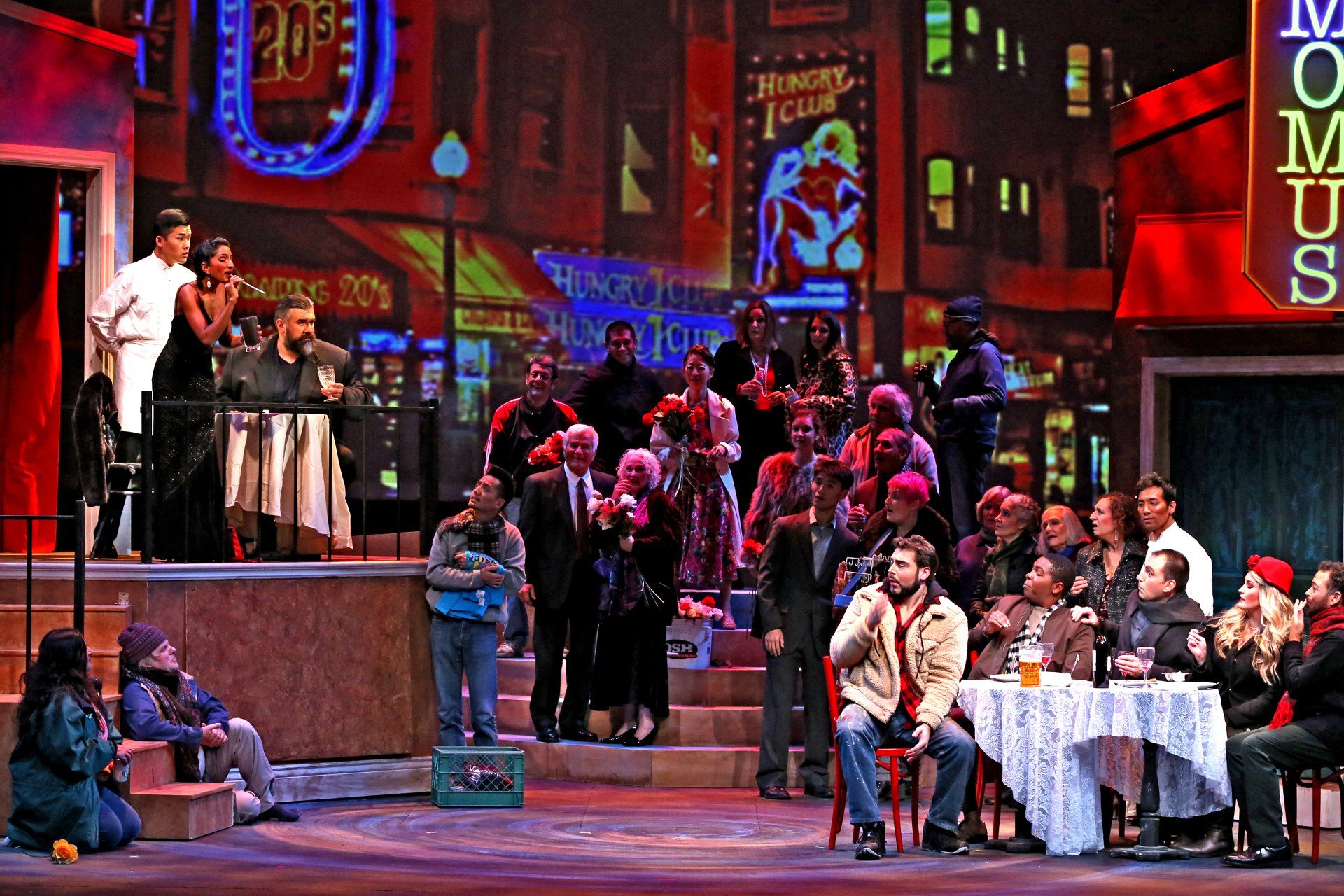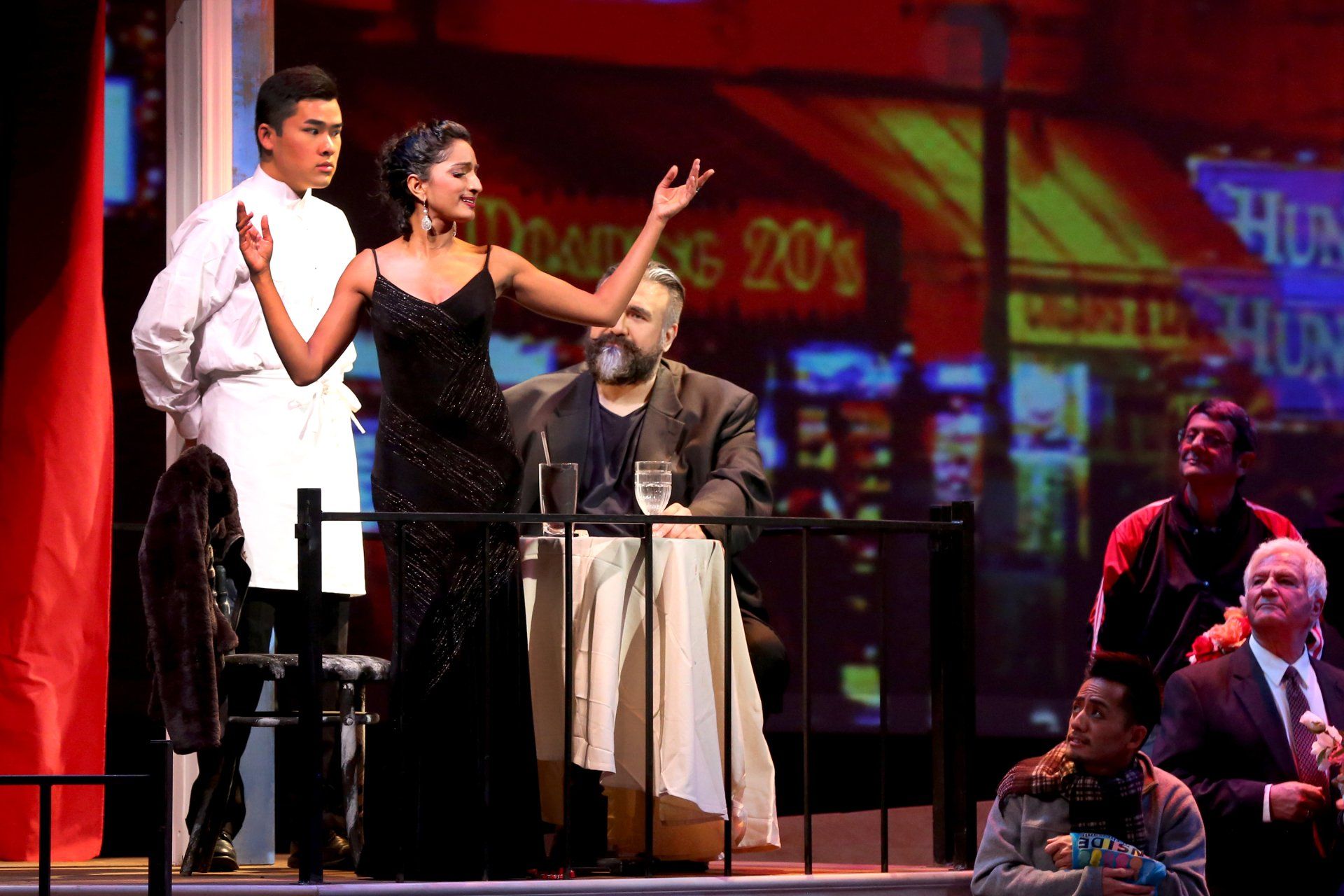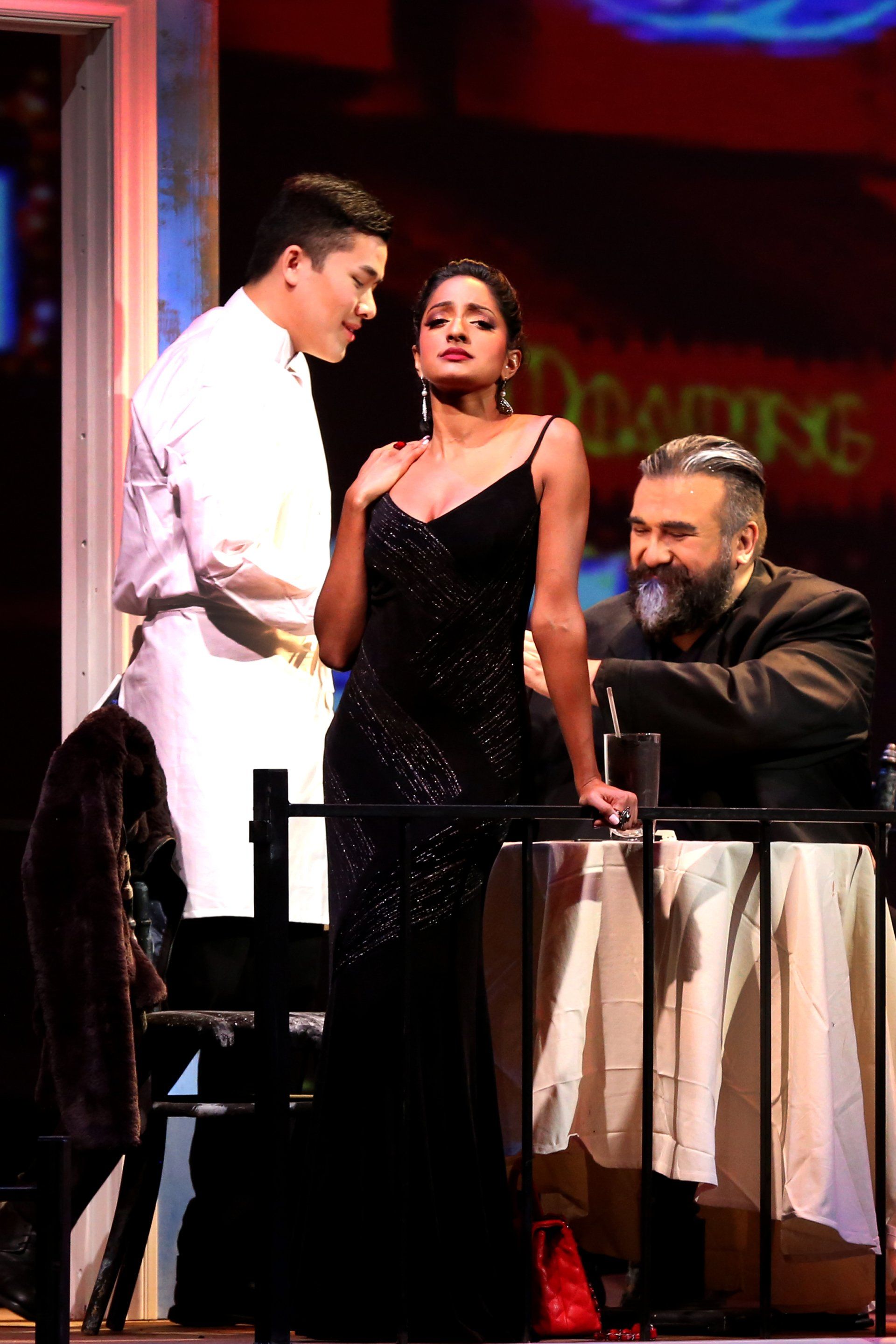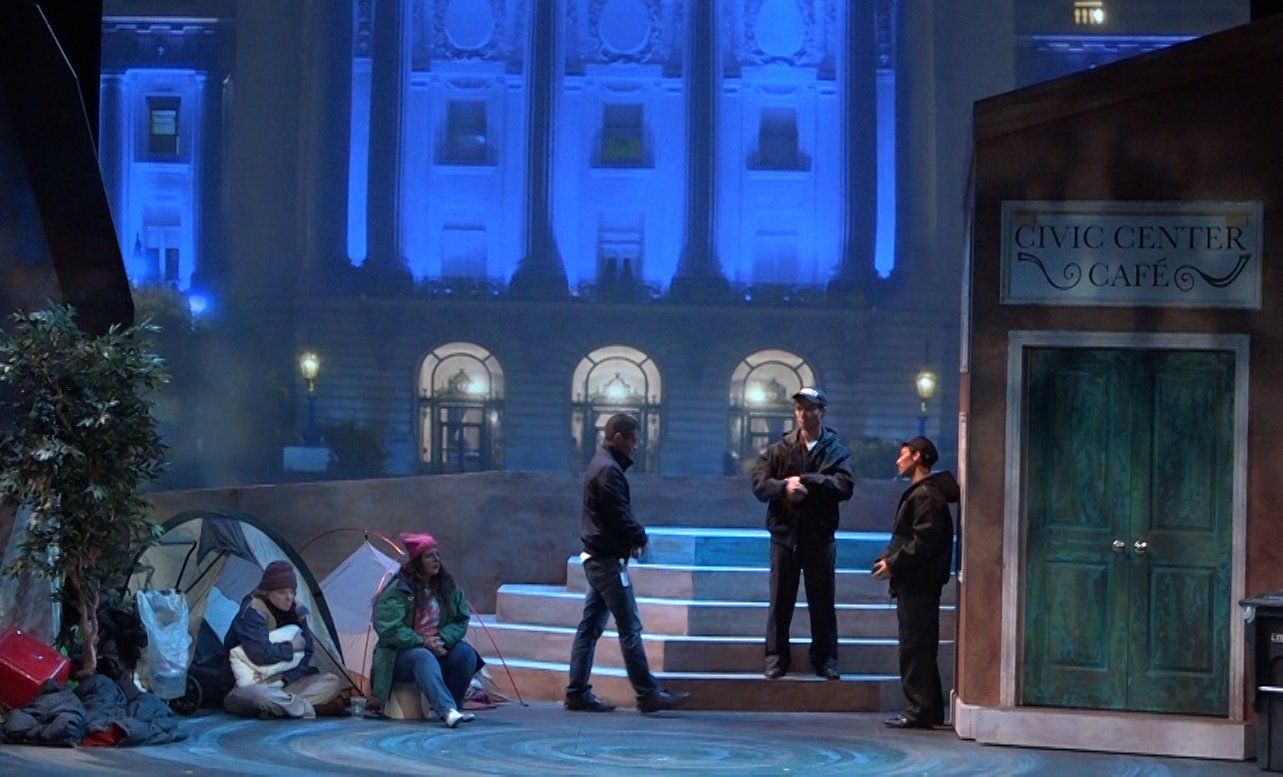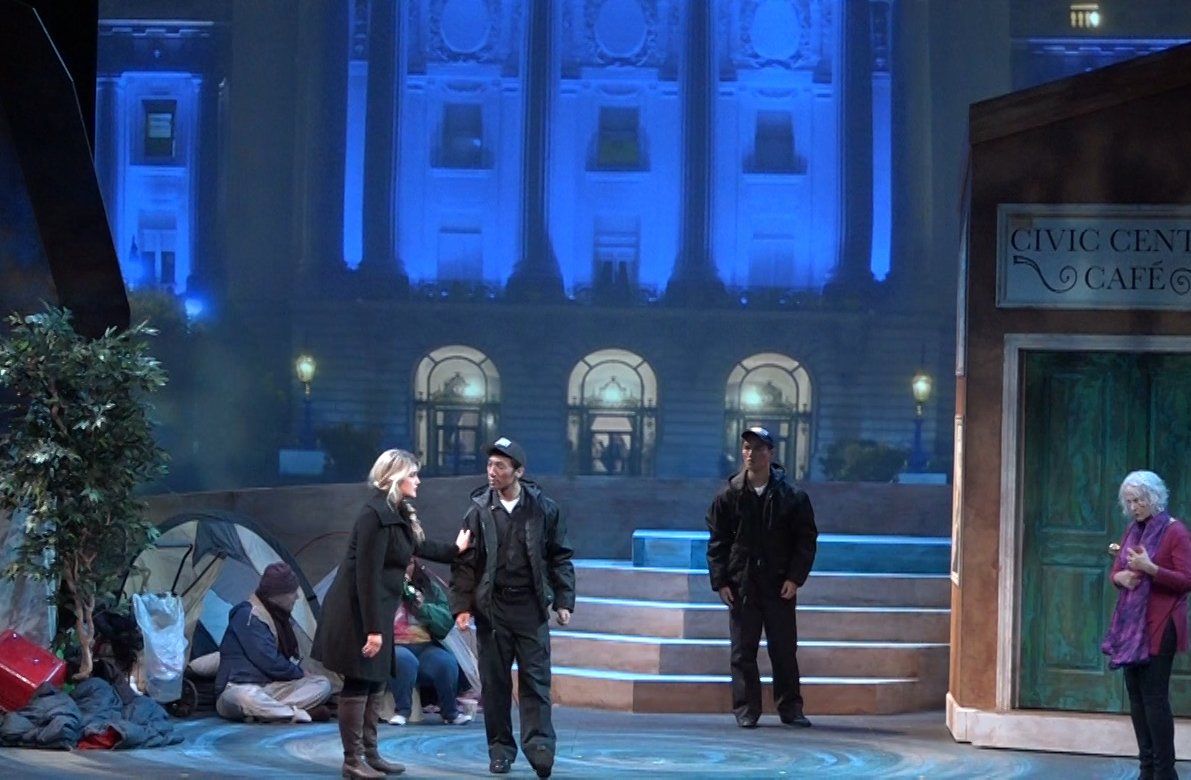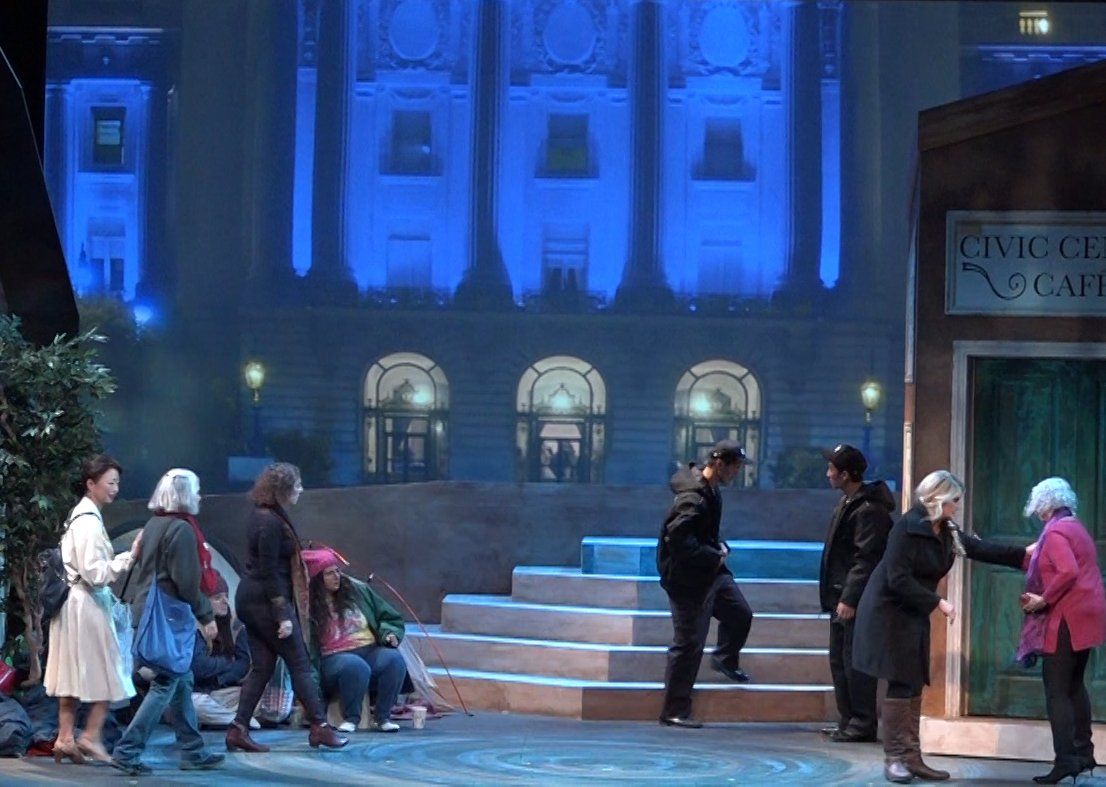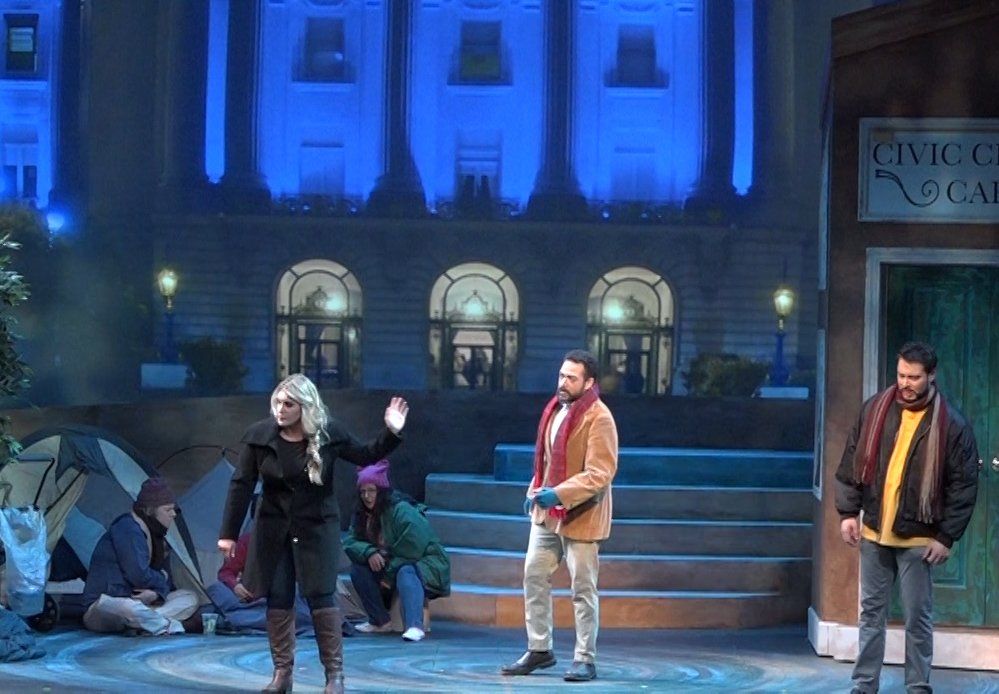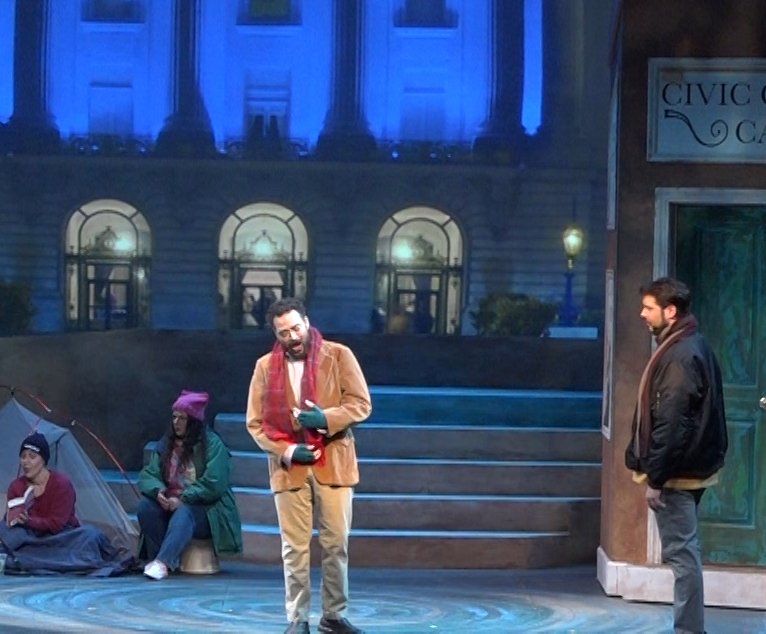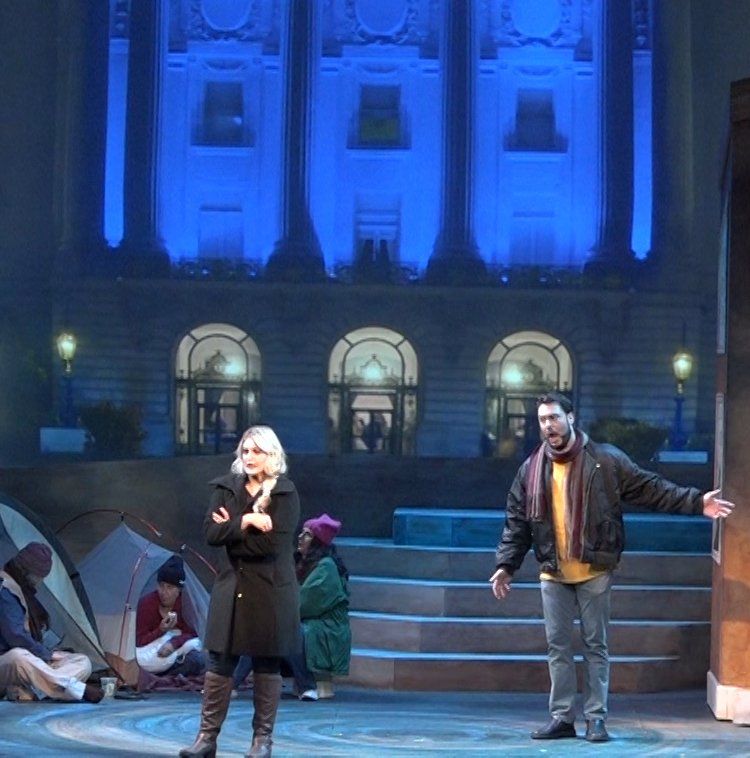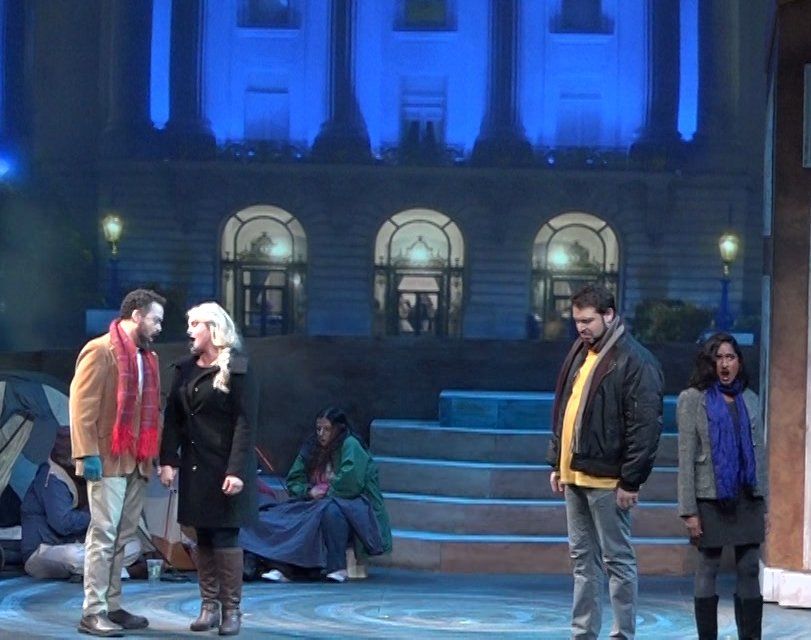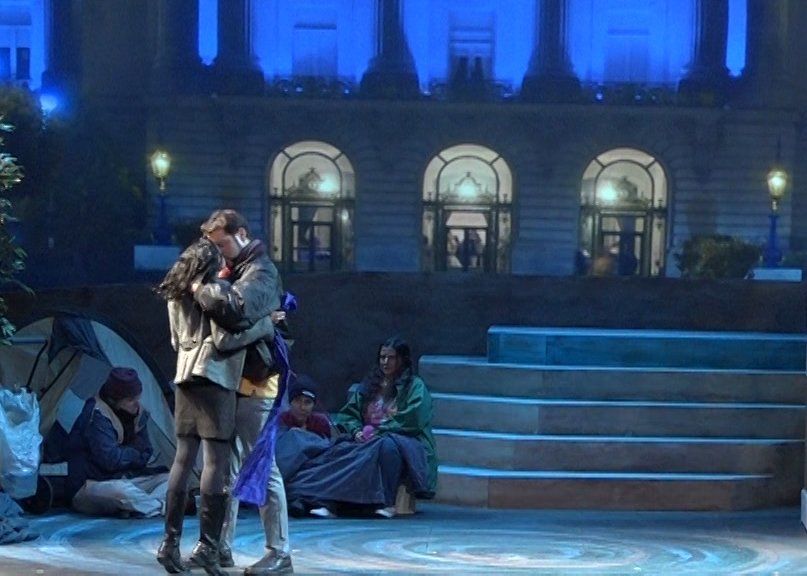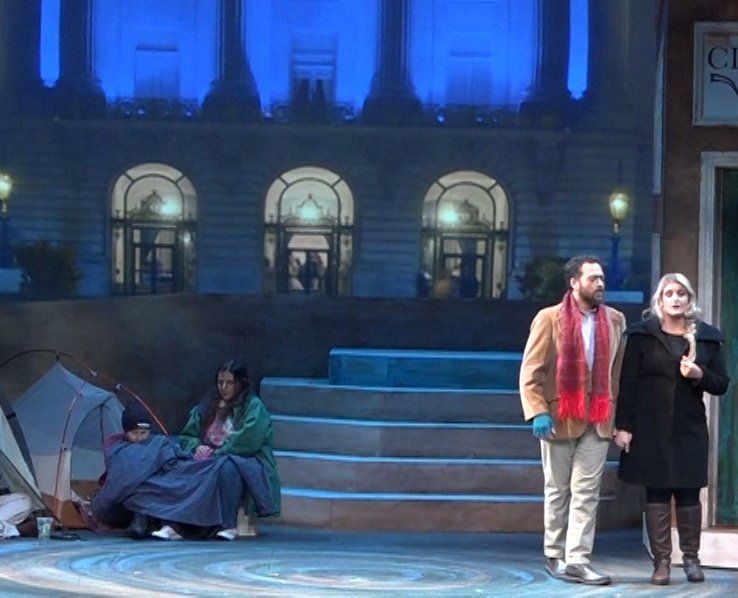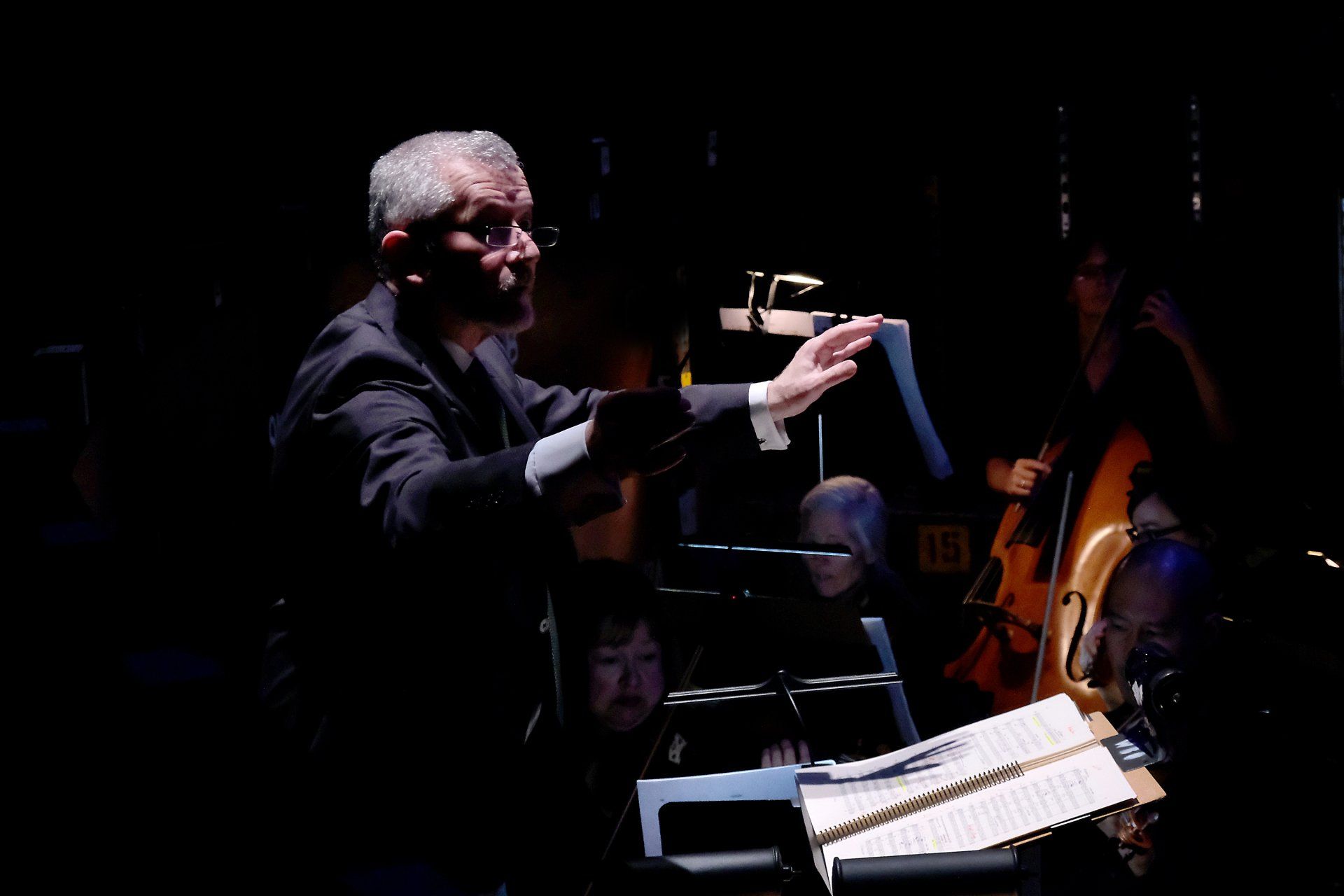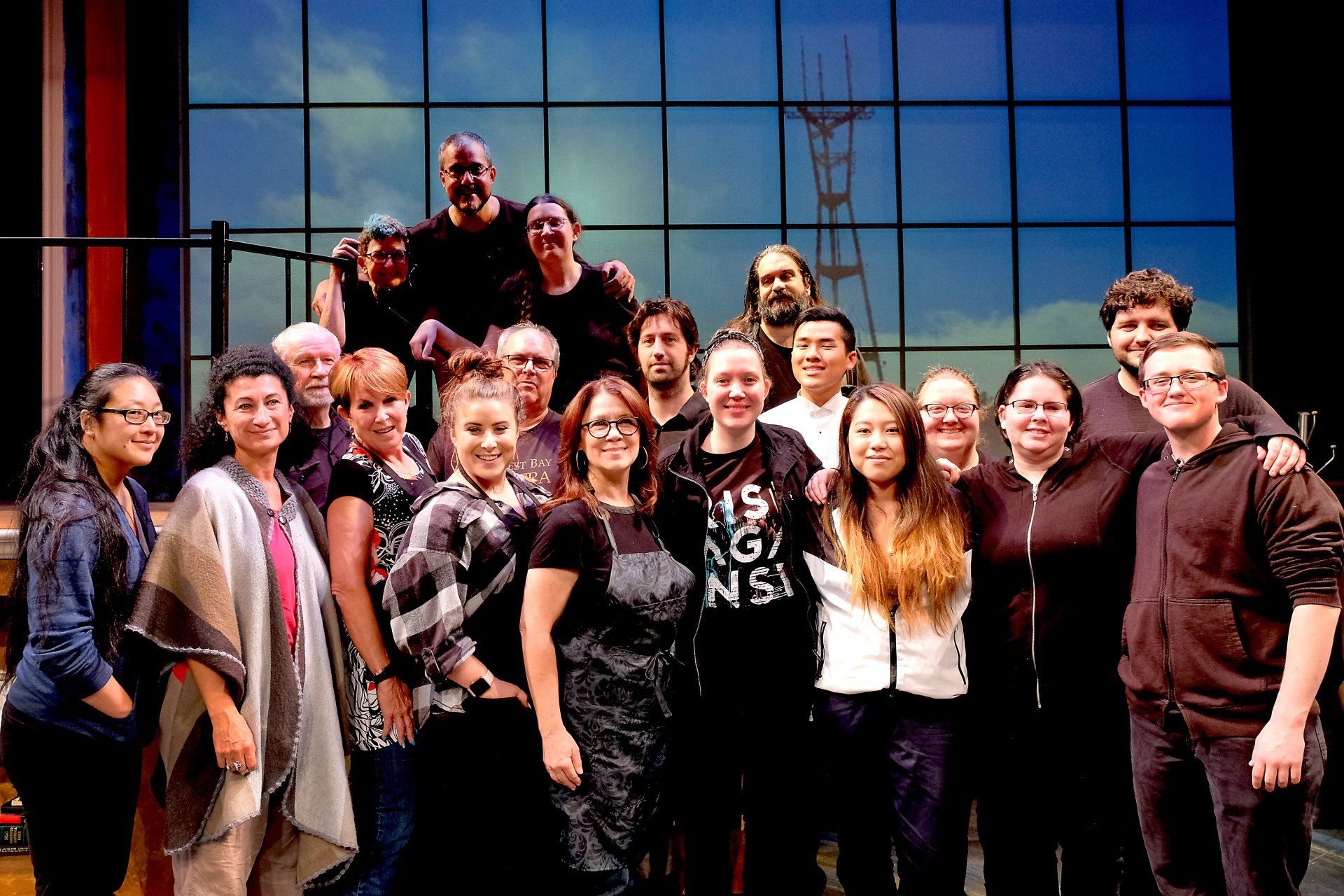
About La bohème
Creative Team
Cast
Chorus
Orchestra
Production Staff
-
Button
L to R: Marcello (Jason Duika), Colline (Brandon Bell) and Rodolfo (Nathan Granner) - Act I
-
Button
Schaunard (Kiril Havezov) - Act I
-
Button
L to R: Rodolfo, Schaunard, Colline and Marcello. Seated: Benoit (Karl Kaminsky) - Act I
-
Button
Mimi (Julie Adams) and Rodolfo (Nathan Granner) - Act I
-
Button
Mimi (Julie Adams) and Rodolfo (Nathan Granner) - Act I
-
Button
Rodolfo (Nathan Granner), Mtro Moscovich and the WBO Orchestra - Act I
-
Button
Rodolfo and Mimi - Act I
-
Button
Mimi (Julie Adams) - Act I
-
Button
L to R: Mimi, Rodolfo, Marcello, Colline and Schaunard - Act II
-
Button
Children from the Silicon Valley Boychoir - Act II
-
Button
Foreground left: Parpignol in drag (Carmello Tringali). Children from the Silicon Valley Boychoir - Act II
-
Button
Center: Jinjia (Max) Liu and children of the Silicon Valley Boychoir. Far left: Parpignol (Carmello Tringali) - Act II
-
Button
L to R: Marcello (Jason Duika), Colline (Brandon Bell), Schaunard (Kiril Havezov), Mimi (Julie Adams) and Rodolfo (Nathan Granner) - Act II
-
Button
L to R on platform: Musetta (Maya Kherani), Alcindoro (Karl Kaminsky).
On lower level: Marcello (Jason Duika), Colline (Brandon Bell), Schaunard (Kiril Havezov), Mimi (Julie Adams) and Rodolfo (Nathan Granner) - Act II
-
Button
Musetta (Maya Kherani) and Alcindoro (Karl JKaminsky) - Act II
-
Button
Musetta (Maya Kherani) and Alcindoro (Karl Kaminsky) - Act II
-
Button
Act III-Opening-2. Men from the chorus.
Still from video
-
Button
Act III Opening-1. Men from the chorus.
Still from video.
-
Button
Mimi (Julie Adams) and Rodolfo (Nathan Granner) - Act III
-
Button
Act III - Women from the chorus.
Still from video.
-
Button
Act III - Mimi (Julie Adams) and members of the chorus. Still from video.
-
Button
Act III - Mimi (Julie Adams) and members of the chorus. Still from video.
-
Button
Act III - Mimi (Julie Adams), Rodolfo (Nathan Granner) and Marcello (Jason Duika). Still from video.
-
Button
Act III - L to R: Rodolfo (Nathan Granner) and Marcello (Jason Duika). Still from video.
-
Button
Act III - Mimi (Julie Adams) and Marcello (Jason Duika). Still from video.
-
Button
Act III - L to R: Rodolfo (Nathan Granner), Mimi (Julie Adams), Marcello (Jason Duika) and Musetta (Maya Kherani). Still from video.
-
Button
Act III - Musetta (Maya Kherani) and Marcello (Jason Duika) kiss and make up. Still from video.
-
Button
Act III - Mimi (Julie Adams) and Rodolfo (Nathan Granner) decide to stay together until the spring. Still from video.
-
Button
Rofolfo (Nathan Granner) and Mimi (Julie Adams) - Act IV
-
Button
Maestro Moscovich and the WBO Orchestra
La bohème production team.
Back row, L to R: Judy Bogart, Igor Vieira, Sarah Terman, Michael Palumbo. Middle Row, L to R: Rudy Schroeter, Kevin Scholl, Gregory Holmes, Phillio Nguyen, Natalie Peck, Jordan Allegro. Front Row, L to R: Giselle Lee, Abra Berma, Lisa Cross, Marissa Bonahoom, Lisa Kester, Savanna Hall, , Daniel Levinthal, Rachel Katin.
- Read the review in the Palo Alto Weekly
Uploaded: Wed, Oct 17, 2018, 1:19 pm
A modernized masterpiece
West Bay Opera sets 'La bohème' in contemporary SF
by Yoshi Kato / Palo Alto Weekly
There are moments throughout West Bay Opera's inspired interpretation of Giacomo Puccini's "La bohème" when audience members can be forgiven for forgetting that they're watching a work that premiered more than 112 years ago.
As WBO's General Director and Conductor José Luis Moscovich pointed out in his introductory remarks last Sunday afternoon, the classic opera's main themes of homelessness, health care and income inequality are as relevant as today's headlines, tweets and Facebook posts. And by transporting the setting from Paris in 1830 to the present day some 35 miles northwest of the Lucie Stern Theatre, in San Francisco, the visual aspects of WBO's production (with stage direction by Igor Vieira, set and lighting by Michael Palumbo, costumes by Abra Berman and projection design by Frederic Boulay) resemble a television miniseries one might binge rather than a traditional opera.
When the curtain is drawn on Act I, the setting is not a studio in the City of Light's Latin Quarter but rather an apartment in the Castro. A familiar image of Sutro Tower on Twin Peaks is projected on the dwelling's oversized window. Struggling visual artist Marcello (portrayed with great depth by Jason Duika, making his WBO debut) is using a can of spray paint, and not a brush and palette, while wearing an oversized plaid shirt with a hoodie underneath.
There's instant chemistry and camaraderie between Duika and Nathan Granner, who is a pathos-filled Rodolfo. Portraying the poet and main male love interest, he's also making his WBO debut, as are Julie Adams (Mimi, the illustrator and main female love interest), Brandon Bell (the philosopher Colline) and Karl Kaminsky (both Benoit the lusty landlord and Alcindoro the sugar daddy). The male starving artists in Act 1, including Kiril Havezov as Schaunard the musician, bring an authentic sense of brotherhood and have voices that blend well together while maintaining distinct individuality.
"La bohème's" success can rest largely on how Mimi is portrayed, and Adams infuses the role with both a bright light and ultimately a well-earned sense of tragedy around which the other characters can orbit. Her duets in Act 1 with Granner as their characters' love quickly evolves and with Duika in Act 3 as she confesses and sorts out her feelings convey different emotions and are equally compelling.
There was a long pause, but not an actual intermission, between Acts 1 and 2, long enough that a couple of patrons stood up to stretch their legs. But the wait was well worth it, as the extensive set change for Act 2 set up a bustling North Beach complete with familiar neon signs and the story's Café Momus placed at the corner of Columbus Avenue and Broadway.
Set on Christmas Eve 2018, it's a bustling scene populated by street vendors, restaurant diners and children. The diversity of ages and faces ensured that it better reflected today's San Francisco, and members of the chorus and Silicon Valley Boychoir and others were involved in their own stories in the background like in a Robert Altman film. It was dizzying at times to read the supertitles, which are above the left and right sides of the stage at what seemed like a 45-degree angle; follow the action of the main characters to the left and right (including Maya Kherani's dynamic Musetta, who's introduced in this act); and also peek into the lives of the others.
There are details throughout Act 2 that authentically reflect the contemporary setting: One woman has dyed pink hair, and a homeless character who returns in Act 3 is wearing a pink Women's March pussy hat. When Musetta makes a scene in front of both lover Alcindoro and past flame Marcello, it's a viral video moment in the making that's captured by a sea of smartphones.
Technology is further acknowledged as Carmelo Tringali's Parpignol, the toy vendor, now sells electronic "gadgets" with screens that particularly attract the Silicon Valley Boychoir members, naturally. The first half's climax ends in a parade that is switched from a military to a San Francisco Giants Giants one. (It's so modern that the two jerseys worn are of current players: pitching staff ace Madison Bumgarner and starting third baseman Evan Longoria.)
"La bohème's" other themes are brought to the forefront in the second half. Act 3 is set in Civic Center Plaza with the projection showing the illuminated back steps of City Hall. The homeless characters are familiar to anyone who has visited the City by the Bay in the past dozen years. Mimi's illness, first introduced in Act 1, has worsened two months later. And as essentially an independent contractor in today's terms, she has no way of addressing it.
Act 4 returns to the apartment and brings all the artists from Act 1 plus Mimi and Musetta together for a tragic conclusion.
As was debuted in May 2017 with WBO's take on Strauss' "Salome," the orchestra is divided into three parts. The strings and harp are in the pit with Moscovich, while the woodwinds, brass and percussion are situated in the left and right wings of the stage. This gives a natural sense of stereo and also allows for a larger instrumentation for the space.
This version of "La bohème" emphasizes the sense of community in the story. In the talk back after Sunday's performance, cast members revealed how close they became. And that could be both felt and heard in this production, which has two more performances this weekend.
Freelance writer Yoshi Kato can be emailed at yoshiyoungblood@earthlink.net.
- Read the review in the San Francisco Classical Voice
West Bay Opera Hits a High Mark With La Bohème
BY ILANA WALDER-BIESANZ , October 16, 2018 WEST BAY OPERA
As West Bay Opera General Director José Luis Moscovich pointed out, 19th-century Paris and 21st-century San Francisco have plenty in common. Artists struggle to make rent, healthcare is expensive, and friends share small apartments to make ends meet. Voilà: the scene is set for La bohème.
Director Igor Vieira used the modern setting to make his production relaxed and fun. The characters’ movements and interactions were natural, without the grandiose posturing that sometimes emerges in operatic tragedy. Colline and Schaunard were presented as a couple, emphasizing Marcello’s (and, later, Rodolfo’s) loneliness. A highlight of the staging came in Act IV when they jousted using rolling chairs for horses and umbrellas for lances. Their silly exuberance was infectious – perfect for a bunch of rowdy twenty-somethings trying to make it in the city. The characters’ relatability also made the second half of the opera especially devastating. (I cried more over this bohème than any other bohème I’ve seen.)
A few missed details marred an otherwise-superb show. Mistimed lighting cues, misaligned projections, mispronunciations, and ghastly Act IV makeup on Mimi should be easy to fix for future performances. The production also would have worked better if it had not overdone the San Francisco location to the point of parody. The celebratory parade for a Giants victory at the end of Act II was strangely disconnected from the text and from the rest of the act. The stage was crowded with stereotypical San Francisco staples: cross-dressing, tent encampments, “will code for food” signs. Choristers’ background business that was supposed to contribute to the atmosphere was instead badly acted and distracting.
Bay Area operagoers will not be surprised to read that soprano Julie Adams stole the show as Mimi. Her ringing sound filled the small Lucie Stern Theatre. But Adams has acting chops to go with her golden voice and ingenue looks. Her Mimi was playful and sunny, and also clearly very sick. Her voice dropped to a pained, husky whisper during Act IV. Kudos to West Bay for casting a Rodolfo who could keep up with her. Nathan Granner wowed with tons of squillo on his top notes, honey tone, and sensitive dynamic choices, especially during “Che gelida manina” (What a cold little hand). His angst-filled facial expressions tugged at the heartstrings.
Beyond the main couple, casting was uneven. As Marcello, Jason Duika sang with glorious round tone and unimpeachable legato, but mushy diction. Maya Kherani’s Musetta boasted shimmering high notes and stunning looks (and clothes). Brandon Bell’s Colline and Kiril Havezov’s Schaunard had charming onstage rapport but couldn’t match the rest of the principal cast vocally. Karl Kaminsky played both the landlord Benoit and Musetta’s wealthy patron Alcindoro with wonderful comedic ability. He artfully mixed rich, rolling notes with squeaks, screams, and nasal phrases.
In the pit, José Luis Moscovich kept the music moving briskly — an important consideration because a delayed start and gratuitous extra intermission (between Acts III and IV) made for a late night! The orchestra played well despite the logistical difficulties of being split across multiple levels. (All 26 instruments didn’t fit in the theater’s small pit.) I especially appreciated their punchy take on the Act II march and the sinuous flow of the strings in Mimi’s and Rodolfo’s Act III duet. Occasional struggles by the brass section did not detract from the orchestra’s impassioned delivery of Puccini’s score.
As a recent transplant to Palo Alto, I’m delighted to learn that opera of this quality is happening in my neighborhood. I’ll certainly be back for more.
Ilana Walder-Biesanz reviews opera and theater for San Francisco Classical Voice, Opera Online, Bachtrack, and Stark Insider. She studied in England as a Gates-Cambridge Scholar (European Literature and Culture) and in Germany as a Fulbright Scholar (theater studies).
- Read the advance article in the San Jose Mercury News
West Bay Opera’s ‘La bohème’ finds a modern setting in San Francisco
By JOHN ORR | Bay Area News Group
October 12, 2018 at 6:34 am
“La bohème,” the popular opera by Giacomo Puccini, is a tale of poor bohemians in 1830s Paris.
“It was during the reign of Louis Philippe, a time of great excess and great income equality, worse than before the French revolution,” said West Bay Opera’s José Luis Moscovich during a recent interview. “The poor had gotten much poorer, the middle class was really strapped, and the rich were living extravagantly.
“In 1830, Paris had yet to see the improvements that were to come in the 1870s,” Moscovich said. “It was still a medieval labyrinth. There was a piling up of people in rental spaces. They were very poor, there was poor sanitation. Artists were constantly being pushed out, unable to get a footing in the cultural capital of Europe.”
When Moscovich wanted to find a more modern setting for the opera, he found a perfect place: today’s San Francisco.
“The parallels are striking,” Moscovich said. “Here we are in San Francisco, people are being pushed around, people are living in tent cities, not just in San Francisco, but also in Palo Alto (where West Bay Opera is based). There are people who aren’t able to afford basic food and services, in the wealthiest region in the world, because of Silicon Valley.”
According to San Francisco’s biannual census, there are more than 7,000 homeless people in San Francisco, and there are many thousands of homeless, including people living in cars and recreational vehicles, all over the Bay Area.
Including on Lambert Street in Palo Alto, near the West Bay Opera building.
“La bohème” is about Mimi, a starving embroiderer, and Rodolfo, a writer who has been forced to burn his manuscript to stay warm. They fall in love, but their story takes tragic turns.
“It has a universal theme, it’s a love story,” said Moscovich, “but the backdrop is very relevant. It’s good to relate to the story in more than one way. It isn’t just a love story.”
Placing the tale in San Francisco will certainly help the audience recognize the opera’s powerful social themes.
West Bay Opera is renowned for its creative, powerful visuals in its sets, and the stagings for “La bohème” are meant to clearly evoke San Francisco.
For the first act, instead of the 1830s Paris garret, there will be an attic in a Castro District Victorian house. It will have views of Twin Peaks and the Sutro Tower.
Act II takes viewers to North Beach, “a place that has a long history of catering to sailors, when it was a harbor,” said Moscovich. “The Carol Doda strip show is gone now, but the neon signs are still there. It’s where they (Rodolfo and Mimi) go on Christmas Eve. The café has the same name as in the (original) opera — Cafe Momus.”
Act III visits another well-known San Francisco spot. “In the original, you have the entry point to Paris, a customs office,” said Moscovich. “We don’t have that here, so we’re going to use Civic Center Plaza — City Hall with the big dome — with people queuing up to be scanned for metal before going into City Hall. It’s a place with a bunch of homeless people. We’ll see the misery of starting the day in San Francisco in the cold and fog.”
Act IV returns to the attic for Mimi’s tragic end.
Moscovich will again be conducting an orchestra that is too large for the pit at the Lucie Stern Theatre, so will split the musicians between the pit and the stage.
“The amount of sound and the balance is so much better,” said Moscovich. “That means, because of the sight lines, we are more constrained on stage in terms of movement. We compensate for the reduction in available stage by adding more levels. The café is in three different levels, the garret is in two levels.”
The show will also use projections, a technique West Bay Opera has used to great effect in the past.
“Our two principals, Mimi and Rodolfo, are just fantastic,” said Moscovich. “There is amazing chemistry between them. Julie Adams (an Adler Fellow, and winner of the 2014 Met Auditions) is a fantastic Mimi. Nathan Granner is a match for her as Rodolfo.”
The opera will be sung in Italian, with English supertitles. There will be four performances, over two weekends.
Opera
What: “La bohème”
Produced by: West Bay Opera
Featuring: Julie Adams, Nathan Granner, Jason Duika, Maya Kheran, Brandon Bell, Kiril Havezov, Karl Kaminsky, and The Silicon Valley Boychoir
When: 8 p.m. Friday, Oct. 12; 2 p.m. Sunday, Oct. 14; 8 p.m. Saturday, Oct. 20; and 2 p.m. Sunday, Oct. 21
Where: Lucie Stern Theatre, 1305 Middlefield Road, Palo Alto
Tickets: $40-$85. 650-424-9999 or www.WBOpera.org
See this and other articles by John Orr at:
https://www.mercurynews.com/2018/10/12/west-bay-operas-la-boheme-finds-a-modern-setting-in-san-francisco/
Our productions are made possible, in part, by the generous support of our key partners:


